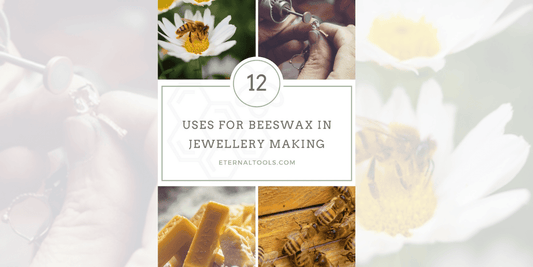12 Uses for Beeswax in Jewellery Making
Beeswax is a versatile essential on any jeweller’s bench. It has a multitude of uses in jewellery making—from lubricating tools to sealing and polishing—and as a bonus, it’s a sustainable, natural product that helps support the survival of our bee populations.
Whether you're lubricating saw blades or conditioning thread for beading, beeswax earns its place as a workshop staple. We recommend using 100% natural beeswax, which is less oily than bleached varieties and leaves minimal residue on your tools.
And when you’re done at the bench? Why not seal some homemade cheese with it—seriously! Curd Nerd has a great guide for that.
Let’s dive into how you can put beeswax to good use in your jewellery studio:
1. Lubricate Jewellery Saw Blades
Applying beeswax to your saw blades helps them glide smoothly through metal, reducing resistance, breakage, and wear. Once your blade is tensioned in the saw frame, swipe the blade’s back across your beeswax block before cutting.
Want more tips? Check out our guide on using a jewellery saw.
2. Condition Thread and Cord for Beading
Waxing thread helps prevent fraying, tangling, and knotting—essential when stringing beads or pearls. If your beeswax is too crumbly, melt it and mix in a tiny amount of olive oil to soften it.
Bonus tip: Shape beeswax into a fine point to create a DIY “pick-up stick” for tiny beads.
3. Pick Up Small Stones and Beads
Use a small lump of beeswax (or some warmed and shaped on a pegwood stick) to pick up delicate stones, pearls, and findings. If it’s too sticky, reduce tackiness with a touch of ash.
4. Seal and Protect Oxidised Silver
Beeswax acts as a sealant to protect the patina on oxidised silver. Gently rub a small amount on with a soft, clean cloth to slow down the natural shine that develops over time.
For inspiration, check out jeweller Cecilia Stamp’s aftercare tips.
5. Transfer Designs to Metal
Rub a thin layer of beeswax onto your metal surface to create a receptive base for transferring designs. Simple and effective.
6. Lubricate Wire for Drawing
Beeswax is a brilliant lubricant when pulling wire through a drawplate. It reduces friction and makes the job easier. Learn how with Hans Meevis’ tutorial.
7. Polish Stones and Pebbles
Buff your beach pebbles or gemstones with beeswax for a natural, satin-like shine. Always use a soft cloth free from other compounds or abrasives.
8. Lubricate Burrs, Drill Bits & Tools
Beeswax reduces friction and heat when using drill bits, burrs, and steel tools. It also helps prevent splintering when drilling wood and improves the life of your tools.
9. Smooth Movement in Lampworking Tools
Lightly coat your stainless steel lampworking tools with beeswax to help them glide smoothly on glass and prevent oxide build-up. Heat the tool first, swipe it through the wax, and remove any excess. (Don’t use wax on gripping tools.)
10. Woodworking & Clock Restoration
Beeswax can be used as a cutting lubricant and wood polish. It restores joints and surfaces, and helps prevent splitting when drilling into wood. Ideal for clock makers and restorers.
11. Prevent Rust on Tools
Coating your hand tools with beeswax protects them from rust and oxidation—especially useful in humid or coastal environments.
12. Lost Wax Casting
Beeswax has been used for centuries in the lost wax casting method. Mix it with a small amount of light oil to make it more pliable, and keep it cool to prevent softening during shaping.
Other Uses for Beeswax
- Polishing guitars, bagpipes, and other instruments
- Making homemade balms, salves, and candles
- Batik fabric dyeing
- Sealing cheese, envelopes, and wooden furniture
- Protecting bronze, archery strings, surfboards, and snowboards
- Creating beeswax wraps as a clingfilm alternative
- Waterproofing shoes, matches, and outdoor gear
- Blackening and finishing steel surfaces
How to Blacken Steel with Beeswax
For a natural blackened finish on steel (often used in art, jewellery, and furniture), you can create an anti-corrosive coating using beeswax and a small amount of raw linseed oil. Here’s how:
- Clean the steel thoroughly and remove any rust.
- Heat the steel in an oven at 220°C (425°F) until it turns a light brown.
- Melt beeswax (and optionally mix with a little linseed oil).
- Apply evenly to the hot steel using a 100% cotton cloth or mounted calico wheel.
- Reheat in the oven for 20–30 minutes (do not use a torch at this stage).
- Allow to cool naturally in a well-ventilated room.
The result is a rich, dark finish that protects against rust and adds character to the metal.


